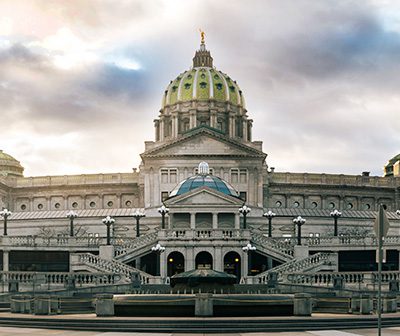On February 5, Governor Corbett unveiled his $28.4 billion budget for the next fiscal year, an increase of $400 million, or 1%, from the budget in place when he took office in 2011.
In contrast to previous budgets, which were shrouded in secrecy before the reveal, this year the Governor crisscrossed the state announcing his major initiatives in advance. These include privatizing both the state lottery and Pennsylvania’s state-owned wine and liquor stores as well as raising several billion dollars for roads, bridges and mass transit by uncapping the so-called oil franchise tax to current market prices.
The Governor’s spending plan restores some of the deep cuts to education and human services that were hallmarks of his first two budgets. These spending increases will depend on both legislative approval and certain legal challenges to the proposed overhaul of Pennsylvania’s public pension spending. Absent those savings, the governor has signaled he will likely have to look for cuts in education. The budget must be approved by July 1, the start of the new fiscal year.
Some state budget items of particular concern to LAMPa’s agenda are below. Look for more as we continue to examine the individual line items and their implications.
Hunger and Poverty
LAMPa works every year for strong funding for the State Food Purchase Program (SFPP), as the primary state-funded vehicle to combat hunger. In his speech, Governor Corbett made special mention of the SFPP in the Department of Agriculture, noting that it is “providing critical help to Pennsylvanians who are at risk of having too little to eat.” The Program is level funded for the second year at $17.338 million, after a $500 million cut two years ago. LAMPa will work to support that funding level in the budget negotiations ahead.
One of the most controversial items in the current year budget was the creation of a human services block grant that combined community mental health services, behavioral health services, intellectual disability community base services, county child welfare special grants, homeless assistance programs and Act 152 drug and alcohol services, while cutting those services 10% overall. It was piloted in 20 counties and will now be extended to all counties on a voluntary basis. The Human Services Development Fund (HSDF) will be level funded at $13.460 million. On February 12, PA House Human Services Committee Chairman Gene DiGirolamo has scheduled a meeting to take up his House Bill 315 aiming to restore the 10 percent cut imposed on those line items captured in the block grant. Specifically he seeks $83 million in supplemental spending. LAMPa is considering support for this bill.
Governor Corbett is seeking to increase funding for subsidized child care, investing over $7million in cost savings into Child Care Services with the intention of connecting approximately 1,400 children with subsidized child care. These children would move off the current slow-moving waiting list. At present, 39 of Pennsylvania’s 67 counties can identify low-income children waiting for subsidized child care, a total of more than 6,500. This funding would provide relief and support to families working their way out of poverty.
Healthcare
The big news of the budget may be what was not quite said about expanding Medicaid under the Affordable Care Act. In his remarks, the Governor appeared to close the door on the issue, but not entirely shut it. He referred in his speech to a letter just sent to Health and Human Services Secretary Kathy Sibelius, advising that “at this time, without serious reforms, it would be financially unsustainable for the taxpayers and I cannot recommend dramatic Medicaid expansion.” He reported that state estimates show “a Medicaid expansion would cost Pennsylvania almost $1 billion of new state taxpayer dollars through fiscal year 2015-2016, ultimately rising to a total cost of over $4.1 billion of new state taxpayer dollars by the end of fiscal year 2020-2021”. He concluded, “We cannot afford to expand a broken system,” and that “the cost to maintain our current Department of Public Welfare programs will increase by $400 million dollars” citing as the main drivers of that increase – “Medicaid and long-term care.”
LAMPa is advocating the expansion Medicaid in order bring health care to over 500,000 working Pennsylvanians, enabling them to access preventive care instead of expensive emergency room treatment. An expanded Medicaid would inject an estimated $38 billion into Pennsylvania’s economy, creating by some estimates hundreds of thousands of health care jobs. It would also prevent hospitals from losing more than $1 billion per year in federal uncompensated care.
Among the unexpected news in the Governor’s budget was a decision to direct $13.49 million in additional funding into the Children’s Health Insurance Program (CHIP), restoring funding to where it was when Governor Corbett came to office. Through an expanded outreach effort, the Governor projects to connect 9,330 more children to CHIP. PA’s CHIP program was recreated in 1992 and has served as a national model of bipartisan leadership and commitment to ensuring that children have access to health insurance.
Access the line by line, executive summary and other state budget information at the Governor’s Budget Office.
Find a complete budget analysis at the Pennsylvania Budget and Policy Center website.





